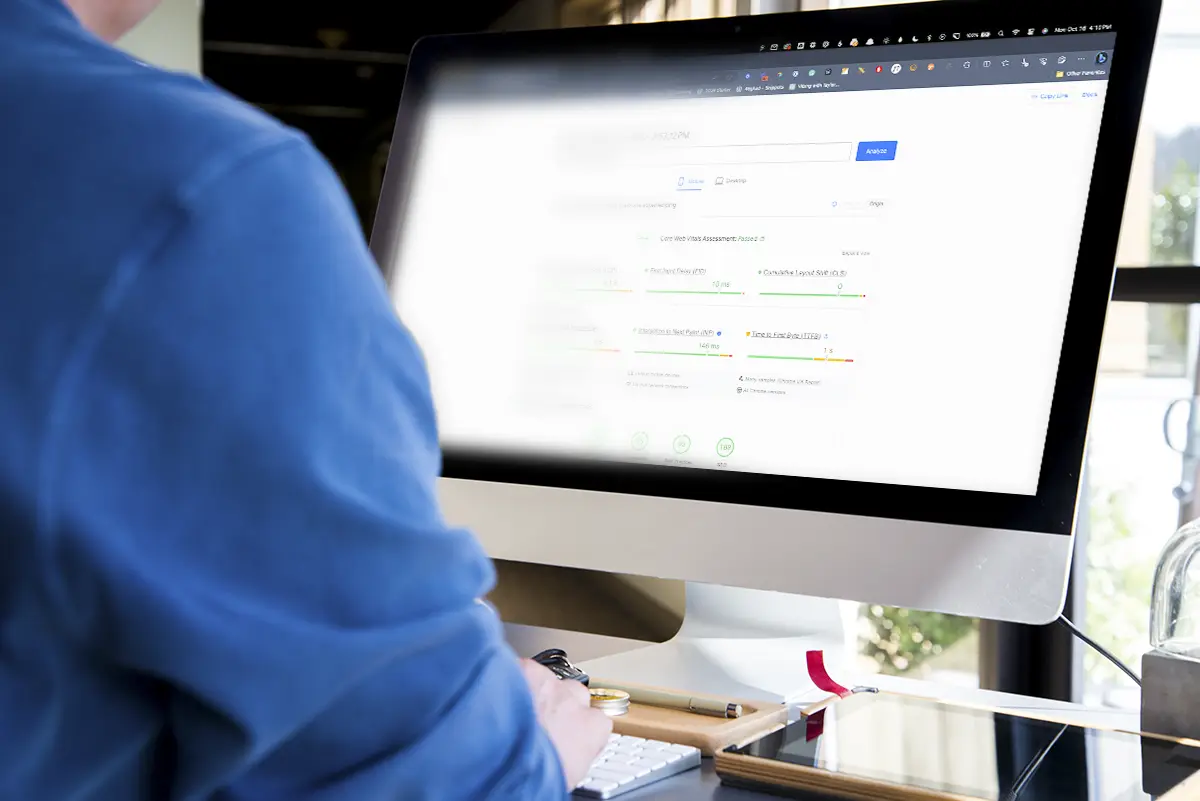In January of 2019, we launched a brand new website (a redesign) for GAL-TECH Roofing. Throughout the course of the year, we developed a plan, and executed our strategy (with minor detours along the way) that has taken them from out of the top 100 search results to owning the top spots in Google for highly-competitive local search queries.
In this case study we’ll explore the search engine optimization strategy we set in place, the month-to-month progress, our challenges and setbacks, and how we could employ the same strategy for other local businesses.
The Problem
The roofing industry is a highly-competitive one— both online and offline. There’s not a town in Texas without a wide variety of companies offering roofing services, and Granbury is no exception.
GAL-TECH started their company just a few months before they approached us and had put together a DIY website using Google’s website builder.
With over 15 competitors within the county (many of whom have been around for years), their website was gaining little traction and getting no organic traffic.
Because consumers don’t need to hire a roofer often, the most likely avenue they would seek one out is through local search online.
Around 60%+ of the clicks in search results go to the top three websites, and any result past the 1st page is lucky to get 5% of the clicks. This means that if you’re not at least on the first page, and really in one of the top three spots, your website will be highly unlikely to get much traffic— and certainly not enough to start measuring its effectiveness in converting people searching Google to paying customers.
In order to achieve the top spots in Google, we needed to find out what people we’re searching for and design and develop a website that would be optimized to rank in the search engines for those phrases.
Our Research
Our research suggested that there were only a few search phrases (we identified 8 originally and added a 9th five months in) that had enough search volume to warrant attention.
For the phrases we identified, there were 3 main competitors that consistently ranked in the top 3 results (or at least the first page).
In order to understand why, we performed in-depth analysis on those websites that included data like:
- How long the website had been in existence
- Their content strategy
- The user experience
- Keyword optimization
- Number of pages
- Backlinks to their website
By having a better understanding of the most important phrases to rank for and why certain competitors were ranking for those terms we could develop a strategy to take advantage of any of the competitors shortcomings, and ensure that we out-optimize all of their strengths.
The Strategy
There were several factors that needed to be considered when putting together the strategy for the redesign.
First was ensuring that we structured the website to give us the best chance for rankings. This included making sure we had dedicated pages for each of the search phrases we were trying to rank for.
On top of that, we needed to provide Google with other trust signals that would indicate that the information on GAL-TECH’s website was not only helpful, but consistent and reliable. This included ensuring we optimize their Google My Business listing, and get the company listed on other directories that commonly display in search results.
Beyond the basics of SEO, our research suggested that the competitors websites were not very user friendly. It was hard to find information a customer would be typically looking for (like phone number, reviews, services)— especially on mobile.
The entire user experience strategy was done with specific users in mind (called avatars). We identified the types of customers that would be using the website, and what they would most likely want to do. This gave us several different user journeys that we could use to test the website with to make sure it would be easy to find the information each avatar needed across both desktop, tablet, and mobile views of the website.
The Launch and Initial Results
After the website was designed and developed we replaced the old website with the new one on January 15th, 2019.
The website was submitted to all the major search engines, and we installed tracking software (Google Analytics) so we could measure the traffic and see how people were using the website.
While it’s tempting at this point to immediately start making tweaks based on any data we receive, we set a 3-month deadline to try and leave the website exactly as it was built (except for some minor tweaks to fix any errors).
By leaving the website untouched for 3 months we could set a new baseline for how the new website performed vs the old website.
After the 3-month period was over we would have enough data that we could begin to make some determinations as to what was working, and what things would need the most attention.
Here are the initial positions in the search results for our 8 search phrases through the first three months (#1 (or top position in results) being best)
| Day of Launch | +1 Month | +2 Months | +3 Months | |
| Search Phrase 1 | 100+ | 70 | 10 | 11 |
| Search Phrase 2 | 100+ | 53 | 15 | 13 |
| Search Phrase 3 | 100+ | 34 | 10 | 11 |
| Search Phrase 4 | 100+ | 32 | 9 | 10 |
| Search Phrase 5 | 100+ | 20 | 8 | 4 |
| Search Phrase 6 | 100+ | 30 | 18 | 17 |
| Search Phrase 7 | 100+ | 43 | 6 | 10 |
| Search Phrase 8 | 100+ | 51 | 18 | 15 |
The data immediately suggested that we were on the right track. Of the 8 search phrases we had targeted, all were within the top 20 results in the first month.
While that’s certainly better than out of the top 100, all but one of the results were outside of the first page— which we know won’t garner much traffic.
Making Adjustments & Executing the Ongoing Strategy
The plan for the very beginning was to be more proactive than reactive— but of course everything can change once a website is “set into the wild”.
While we did feel we made excellent progress for the first 3 months, we knew more improvements would need to be done to ensure GAL-TECH’s website continued to move up toward the top of the results.
Part of this strategy was to reassess the content on all the pages. This led us to make several tweaks to headlines and add additional content that we felt could serve as good resources for the visitors. We added some sections that gave visitors ideas of what to look for in repairs, how to tell if their roof needed repairs or replacement, and how to deal with homeowners insurance.
We also found (through the analytics on the site) that our calls-to-action (the buttons we placed on the site to encourage visitors to schedule an inspection or call GAL-TECH) were being overlooked by some visitors.
Some slight adjustments were made to improve the visibility of the calls-to-action and place them higher on the page.
At this point we implemented the second phase of our content strategy, which is to start publishing blog articles.
The articles would serve a dual purpose:
- To extend the content on the site and give us more opportunities to supply additional information that could be found in search engines (as well as provide more internal linking opportunities for our key pages)
- To provide useful information for homeowners that could be shared on social media.
By increasing the amount of content on the site, as well as encouraging more traffic from social media we know that those would be good indicators to Google that our site was worth displaying on the first page.
We set a modest schedule of 1 blog post per month. While we didn’t produce the blogs exactly on schedule, we ended up providing GAL-TECH with more than 1 blog per month on average (a total of 11 over 9 months).
Rankings by the Month
While continually executing our strategy, we tracked the rankings each month (as well as measuring traffic).
April 2019
By April 4 of our 8 phrases had cracked the top page, and we had our first make it into the 3rd position.
May 2019
In may we saw some fluctuation both up and down (which is typical— rankings are not static). The good news was all except 1 phrase was now on the first page of Google’s search results. At this point we identified one more search phrase we would begin to track (giving us 9 in total).
June — July 2019
Not too many changes in this period— most phrases between #5 and #7 in search results rankings.
August 2019
Now 7 months into our journey we hit our first big set of milestones and goals. The numbers in August showed that 5 of our phrases were now in the top three results, and 2 of those 5 were at the number one spot.
September — December 2019
From September through December the numbers fluctuated slightly, but by mid-December we were top 3 for 6 of our search phrases— four of them were at the #1 spot.
One Year Results
As of today (January 15th, 2020) we are exactly one year from launching our redesign of the GAL-TECH website— here are the results with a comparison to the date we launched:
| Day of Launch | +1 Year | |
| Search Phrase 1 | 100+ | 1 |
| Search Phrase 2 | 100+ | 1 |
| Search Phrase 3 | 100+ | 1 |
| Search Phrase 4 | 100+ | 1 |
| Search Phrase 5 | 100+ | 2 |
| Search Phrase 6 | 100+ | 2 |
| Search Phrase 7 | 100+ | 18 |
| Search Phrase 8 | 100+ | 3 |
| Search Phrase 9 | 1 |
- 5 search phrases in the top spot
- All except 1 in the top 3
Search phrase 7 is the obvious outlier. Because I know this is a public article I don’t want to give away what each of these search terms are (shout out to any of my competitors out there reading this) but I do want to clarify this one bit.
Search Phrase 7 is a complimentary service GAL-TECH offers (which isn’t directly related to roofing). There are actually 2 of these complementary services on the list (along with #8).
In talking with our customer, and understanding that these services didn’t provide enough return on investment for his business we have largely ignored these phrases in any of our content updates or blogs.
A Year in Review
Search Engine Optimization (SEO) is a complicated thing— and there is no one-size-fits-all solution.
I’d be lying if I claimed this was smooth sailing the whole way. There were times (especially early on) that our customer was becoming frustrated by the time it was taking to start getting traffic from organic search results.
It’s understandable for clients to feel this way— but the honest truth is SEO takes time, and there are an almost infinite number of variables that can affect that timeline.
Luckily GAL-TECH fought through the frustration and I was able to convince him to be patient and things would pay off.
One thing that was a bit harder to measure and explain (for the purposes of this article) but worth mentioning is their position in the local “map pack” results (the local results Google shows along with a map). After a year we were able to (with some consistency— keep in mind these things go off Geo-location too, so they can’t be 100% accurate in testing) be featured in the Map Pack for 4 or 5 of the search phrases. This accounted for around 20% of the website’s organic traffic, as well as hundreds of phone calls from people who never even had to visit the website at all.
The result
A phenomenal year for GAL-TECH. While there isn’t a lot of company history to go off of, they smashed through all their sales goals and finished 2019 being booked solid and months in advance.
Organic traffic continued to steadily increase and tracked almost perfectly with their rankings in search engines. Meaning the higher they were ranked the more clicks, visits, phone calls, and ultimately booked jobs they had.
Can This Be Repeated?
If you’ve spent the time reading this case study you’re likely wondering how this can be translated to your business (or you’re a fellow web-developer— hi again!).
The answer is an emphatic yes.
While your strategy might not look just like GAL-TECH’s, it is the principles applied that really make the difference.
By understanding what phrases to target, your competitive landscape, developing targeted content, and continual improvement your business can rank in the search results too.
Of course, there is a lot of detail omitted from this article (can’t be giving all my secrets away, okay?). This takes time. This takes patience. This does require a budget.
For my customer’s confidentiality I won’t reveal the exact number he paid for the website development plus the ongoing SEO services, but it’s much less than he made in return (and it was all a tax write-off!).
I’d love to talk to you about your business and how we could put together a unique strategy that would deliver similar results as GAL-TECH. Fill out my project inquiry form, or give me a call today.




